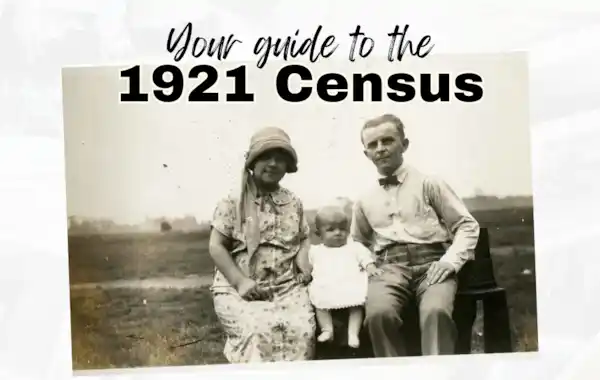The 1921 Census for England, Wales and Scotland is available for family history research. Search it on Ancestry and Findmypast (for England and Wales) and on ScotlandsPeople. Find out how to get the most from this resource with our comprehensive guide to the 1921 Census.
Providing detailed demographic data, the 1921 Census highlights family structures, occupations, and residential locations, giving a vital insight into this remarkable period in our history.
Get your free 1921 Census Research Toolkit
Sign up for the free Family Tree newsletter, and we’ll send you a link to our free census kit featuring:
- 1921 Census fact file
- 1921 Census FAQs
- A mini 1921 timeline
- Family record sheet for you to print out and use
- 'Census Comparison Chart' detailing how the information collected in the census changed over the decades
It's the perfect resource to help you start exploring the records in the 1921 census!
CLAIM YOUR FREE CENSUS RESEARCH KIT
Quick links to the 1921 Census guide
- 1921 Census frequently asked questions (FAQs)
- 1921 Census for England & Wales - fascinating facts
- Widows and orphans in the 1921 Census
- Searching the 1921 Census
- Further reading on the 1921 Census
- Get more family tree advice with the Family Tree newsletter
1921 Census frequently asked questions (FAQs)
When did the 1921 Census become available?
FindMyPast was chosen as the commercial partner for The National Archives to make the 1921 census available online. They captured digital images and transcribed the records to allow researchers to explore the information.
The online release for the 1921 Census for England and Wales was 6 January 2022, via FindMyPast. The census was taken on 19 June 1921 and records information on almost 38 million individuals.
Where can I see the 1921 England and Wales Census?
You can view the digitsed 1921 Census for England and Wales on Findmypast (with an Everything subscription) and on Ancestry.co.uk with a paid Premium subscription. You may also view the digitised 1921 Census at the National Archives premises in Kew, London, as well as at Manchester Central Library and at the National Library of Wale, Aberystwyth.
Where can I see the 1921 Scotland Census?
View the digitised images online at ScotlandsPeople (£1.50 per census page - 6 credits. You can buy bundles of credits from £7.50 a bundle). You may also view it at the ScotlandsPeople Centre, Edinburgh (£15 daily visitor fee to the centre) and at ScotlandsPeople Hubs (Alloa, Glasgow, Hawick, Inverness, Kilmarnock) (again, £15 dail visitor fee - do check hub opening days and times).
Does Ancestry have the 1921 Census?
Yes. From 7 January 2024 Ancestry provides access to the 1921 Census for England and Wales.
Can I view the 1921 Census for free?
You can access the census for England and Wales for free via the hubs detailed above (at Kew, Manchester and Aberystwyth).
How much does it cost to access the 1921 Census for England and Wales?
To access the 1921 Census via Findmypast, you need to register for an account Findmypast, and will also need to pay additional pay-per-view fees of £2.50 to view a transcript, £3.50 to view an original image. If you have an Everything subscription to Findmypast, then the 1921 Census for England and Wales is included.
To access the 1921 Census via Ancestry you will need a paid Premium subscription.
Which countries does the 1921 Census include?
The collection available on Findmypast and Ancestry covers England and Wales. The 1921 Census for Scotland is available via ScotlandsPeople.gov.uk. The 1921 for Ireland was never taken due to the events surrounding the Irish War of Independence.
How many people were enumerated for England and Wales?
37,885,242 persons; 18,082,220 males and 19,803,022 females (Histpop. Part II, statistical notes, p. vii)
What information does the 1921 Census for England and Wales contain?
This census is the most informative yet for family historians.
New information not available on previous censuses includes:
- Place of employment
- Industry in which employed
- Materials worked with
- Name of employer
- Marital status for those 15 or older (with ‘divorce’ as a status for the first time on the census)
- Details of whether or not parents still alive for those under 15
- Whether the person spoken an additional language (for returns in Isle of Man and Wales)
- How many children aged 0-15 years old (with their ages at last birthday) for married men, widows and widowers
Were different questions asked for the 1921 Census (in comparison with previous surveys)?
Yes quite a few!
- Ages were given in years and months.
- Those aged 15 or over were asked whether they were single, married or divorced (divorce had not been specified as an option in previous census decades).
- Details of employer and place of work were enquired about, as the answers were hoped to shed light on how far people were travelling to work, and what their transport requirements would be.
- The ‘famous’ fertility question of the 1911 Census was removed. Rather than asking for the duration of marriage and the age of the children, simply the number and ages of living children under 16 were required.
- Those aged 15 or under were asked to specify if one or both of their parents had died, and if just one, which one.
- The disability question was also absent from the 1921 Census, as it was deemed an unreliable means of obtaining accurate information.
Why isn’t there a 1931 Census for England and Wales?
On the night of Saturday 19 December 1942 the Office of Works, Hayes, Middlesex caught fire – seemingly from an accidentally discarded cigarette (not enemy action, which might be supposed from the 1942 date), which smouldered with disastrous consequences, despite there being six firewatchers on duty at the location that night.
The Office of Works was the location at which all of the 1931 Census records for England and Wales were stored. The fire raged to such an extent that there were no records deemed worth salvaging at the time as a consequence.
How did the Scottish 1931 Census records survive?
They were stored in Edinburgh, so avoided the conflagration that destroyed the English and Welsh census.
Why was the 1921 Census for England & Wales postponed?
The 1921 Census for England & Wales was taken on 19 June, postponed from its original date of 24 April 1921.
We speak now of the ‘postponement’ of the 1921 Census, but when the papers were breaking the news of the Irish census derailment on 1 April, and subsequently that of the English, Welsh and Scottish on 14 April this may have felt more like a ‘cancellation’, which indeed for Ireland it turned out to be.
No ‘Plan B’ date had been scheduled, and it wasn’t until 26 April 1921 that the announcement was given by the General Register Office, Somerset House, that the census was to be taken on the night of 19 June (as reported, for instance in the Hartlepool Northern Daily Mail, 27 April 1921, on page 3).
The reasons for the disruption to the census plans were complex and many.
From our perspective, those of our ancestors who had survived the Great War, and the subsequent Spanish Flu, were the lucky ones. Yet life was still incredibly hard. In February 1921, for example, unemployment was at 1,000,000 but by 10 June that same year it had more than doubled to 2,200,000. And these figures are set against a population half the size of our population today.
In Ireland, meanwhile, the exhortations by Sinn Fein, encouraging the population to boycott the census meant that it was deemed not worth taking it as the figures would have been too inaccurate. In addition to which, conflicts surrounding the Irish War of Independence were also seeing deaths on the streets of both Ireland and Britain.
That the 1921 Census for England, Wales and Scotland went ahead, genealogists today can be thankful. The forms that had been printed for the April distribution were handed out, and from 11 June enumerators set forth with their packets of papers going from door to door.
It seems there were strict instructions that the census forms mustn’t be handed out more than 8 days prior to the census date of 19 June (Daily News, London, 11 June 1921, page 1). Was this the norm… or perhaps a stipulation by an uncertain Government who knew that, having once taken the unprecedented step of postponing the census, it may well be required to do so again…?
1921 Census for England & Wales - fascinating facts
- 38 million people are recorded on the 1921 England and Wales census
- The information is held in 30,000 bound volumes that span 1.6 kilometres on archival shelving
- The 1921 Census came across 12 spent matches, left by the clerks in decades past, in the days when people smoked whilst they worked. Imagine if one of them had been left smouldering? (The 1931 Census for England and Wales was lost in a fire, and the 1941 Census was never taken because of World War II.)
The 1921 Census highlighted huge population changes
-
The population increase between 1911 and 1921 was the lowest population increase recorded since 1811.
- The 1.8 million population increase 1911-1921 was ‘numerically about one half of the increase in the preceding intercensal period; it is less than any corresponding figure since 1811 while proportionately it is far lower than any hitherto recorded’ [details from Census of England and Wales 1921, General Report, England and Wales, 1921 www.histpop.org]
- In 1921 there were 1,720,802 more females than males; in 1911 there had been 1,179,276 more females than males.
- The 1921 census figure for males doesn’t include ‘members of the Army, Navy and Air Force and of the Mercantile Marine who were out of the country on the census night’. [details from Census of England and Wales 1921, General Report, England and Wales, 1921 www.histpop.org]
The 1921 Census cost the nation thousands
-
The cost for the 1921 Census forms for England and Wales to be printed by the Government Stationery Office Press at Harrow was around £20,000, including £16,300 in paper costs. [costs were mentioned in a House of Commons debate, Hansard, 1 March 1921]
-
The total cost of taking the 1921 Census, including staff and materials, was £500,000
There were heavy fines relating to the 1921 Census
- A two-year sentence with hard labour was the sentence faced by any of the 38,000 enumerators of the 1921 Census should they divulge any of the confidential information that they acquired on the forms.
- There was a £10 fine for members of the public who do not fill in/provide the details for their 1921 Census forms, or who provide false information (this is an increase on the previous £5 fine for such form-filling malpractice on the 1911 Census)
- There was a £2 4s fee that each of the 38,000 enumerators of the 1921 Census earned, plus 4s for every 100 people enumerated and 6d for each mile over 5 miles that the enumerator has to travel on his beat.
[page 3, Dundee Evening Telegraph, 29 March 1921]
Separate forms for lodgers, but not boarders
Lodgers were deemed to be a separate household, therefore needing their own census form. Boarders, however, would have their details entered alongside that of the rest of the household.
[Presumably this means that we should also search the 1921 Census by address to ensure that we have found everyone enumerated in a household – otherwise the fact that our family had a lodger may elude us.
Died too soon…
If you have an ancestor who died between 25 April 1921 and 20 June 1921 you will be frustrated that the postponement of the census of England and Wales means that you will not find them enumerated…
But if you have an ancestor who was born in England and Wales between these dates, you will be happily able to search for them – as they will be included, whereas if the postponement hadn’t gone ahead, they wouldn’t have been.
Ex-soldiers as enumerators
The question as to ex-soldiers being employed as enumerators raged on in the months leading up to the census. There were many soldiers out of work, but the argument against employing them was that the role of enumerator was just a temporary position so may preclude them from obtaining work (people accepted as enumerators, but who went back on this acceptance, were fined heavily for doing so).
Widows and orphans in the 1921 census
Just three years on from the end of World War I and in the wake of the Spanish flu pandemic, the 1921 Census took a snapshot of life in England and Wales and found a population forever changed.
For the first and only time, information was gathered on orphanhood status, offering insight into the possible effects of war and pandemic. The 1921 Census was also the first to recognise divorce as a marital condition.
The 1921 Census recorded that just over 11% of all females aged 15 and older were widows, compared with 10% of the same in the 1911 Census; a 1% increase.
More than 11% of all women in 1921 were widows
A larger difference was evident when comparing younger, narrower age groups of females. For example, 1.3% of women aged 25 to 34 years were widowed in 1911. By 1921, that had increased to 3.2% of females in the same age group.
For men in 1921, the proportion was smaller, where 5% of all males aged 15 and above and 0.9% aged 20 to 39 were widowed.
Not all widowed spouses recorded in the census would have lost their husband or wife through war or pandemic, but for comparison, 239,000 widows and 393,000 children received a war pension in 1921 in Britain.
Around 228,000 people were estimated to have died in Britain from Spanish flu a large number of them fit and healthy. It is thought that in the UK, the virus was spread by soldiers returning home from the trenches in northern France during World War I.
Female population of England and Wales outnumbered males in 1921 across all ages
In 1921, the number of females in England and Wales outnumbered males by 19.8 million to 18 million respectively across all ages. This compares with 18.6 million females and 17.4 million males in 1911.
The imbalance between males and females in 1921 was most pronounced among those in their 20s and 30s.
During the first two decades of the 20th century, [government schemes existed to encourage ‘surplus women’ to emigrate to other parts of what was then the British Empire, to try and redress the imbalance].[7]
This imbalance in the number of females to men revealed, in unrounded figures, that in 1921 there was 1.1 female for every 1 male, compared to 1.07 women to every 1 male in 1911.
Orphans counted in the census for the first and only time
Details of orphanhood and dependency status was vital in a post-pandemic and post-conflict 1921. It helped prepare the financial framework of the Widows, Orphans and Old Age Contributory Pensions Act, 1925.
This would have been the first and only time that questions about orphanhood status were asked about children aged 14 and under in the 1921 Census.
That information, laid bare in black and white on the census form, showed for the first time how many orphans there were in England and Wales.
The two cold words on the census form, “father dead”, meant life without the “head of the family” for 730,845 children, as recorded in the 1921 Census. Their absence would leave a lasting legacy for generations to come.
The number of children recorded as “mother dead” was 261,094, almost three times fewer than those without a father. Those who lost both parents numbered 55,245.
Data taken from the second instalment of the Census Unearthed series published by the Historic Censuses Digitisation Project, as part of their statistical archaeology work to make the statistics from 1921 through to 1961 accessible.
Searching the 1921 Census
A century on from the Census being taken, we are lucky to be able to search the records from the comfort of our own homes. Genealogy websites including Findmypast and Ancestry have the 1921 Census available. Find out how to get the most from these records with our guide to searching the 1921 Census.
The census may also be accessed free of charge at three archive hubs:
- The National Archives, Kew
- The National Library of Wales
- Manchester Central Library, supported by the Manchester and Lancashire Family History Society and the Archives+ Team
How to do a basic search of the 1921 Census on Findmypast
Note: you do not need a subscription to Findmypast in order to use the 1921 Census and you do not need to take out a 14 day free trial. You do need to register with the website however.
Once you are logged in you will be able to conduct searches at no charge.
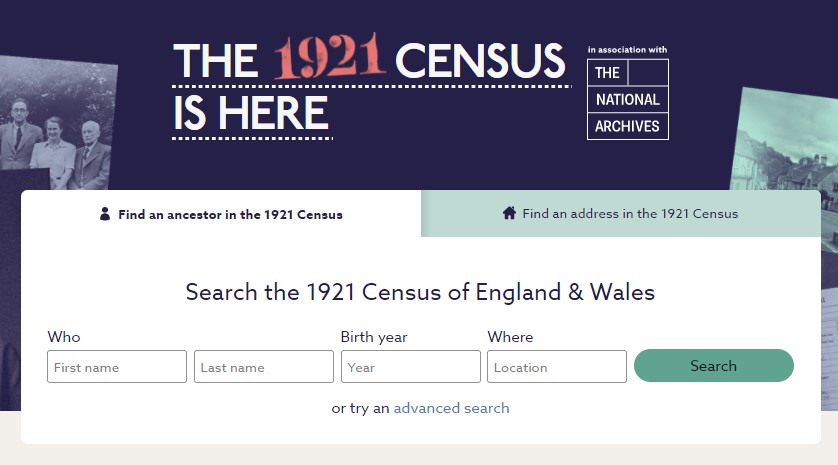
Note that when searching you are entering the year of birth, but the ‘Where’ field is not for place of birth. The ‘Where’ field is for you to enter the place in which you expect the person to be in 1921.
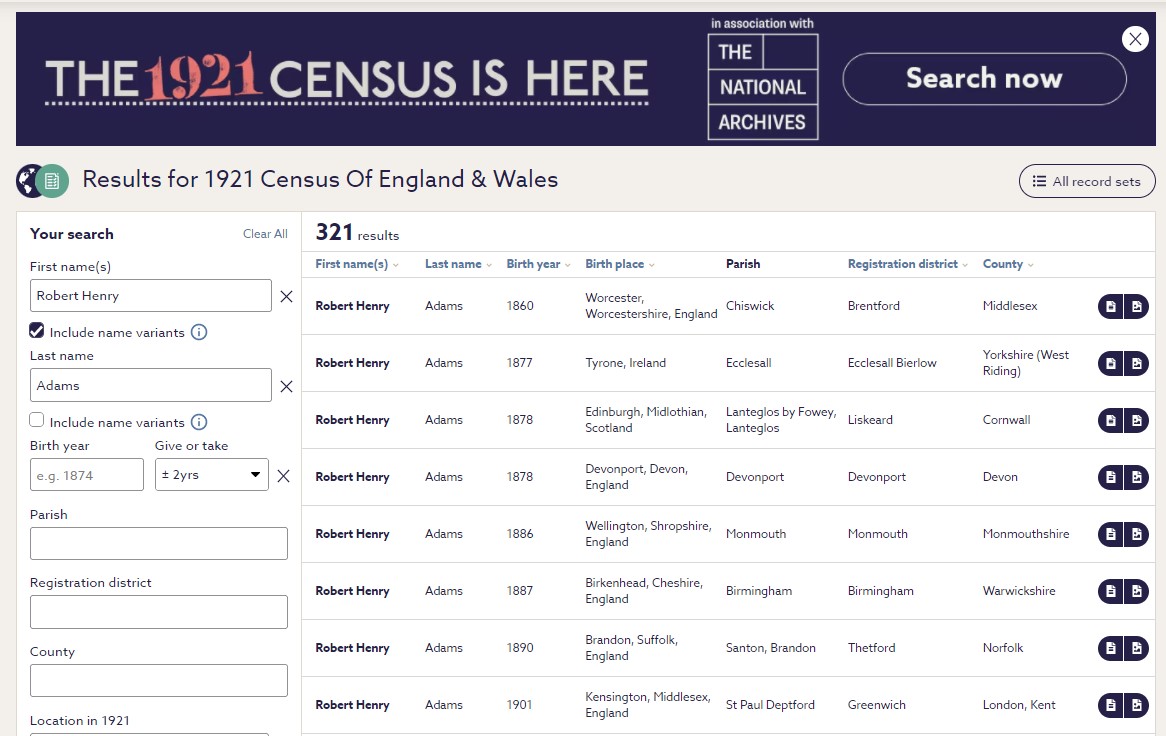
The search results give a detailed combination of facts to help you determine whether the entry is correct before you decide to buy a full transcription or the digitised image of the original page. This is an example of the search results above.
The details include: first name(s), last name, birth year, place of birth, and the name of the parish, registration district and county where the person was living in 1921.
How to do an advanced search of the 1921 Census on Findmypast
If our example above we searched for Robert Henry Adams, and there were 321 results. The advanced search provides numerous fields that you may use to narrow down your search results.
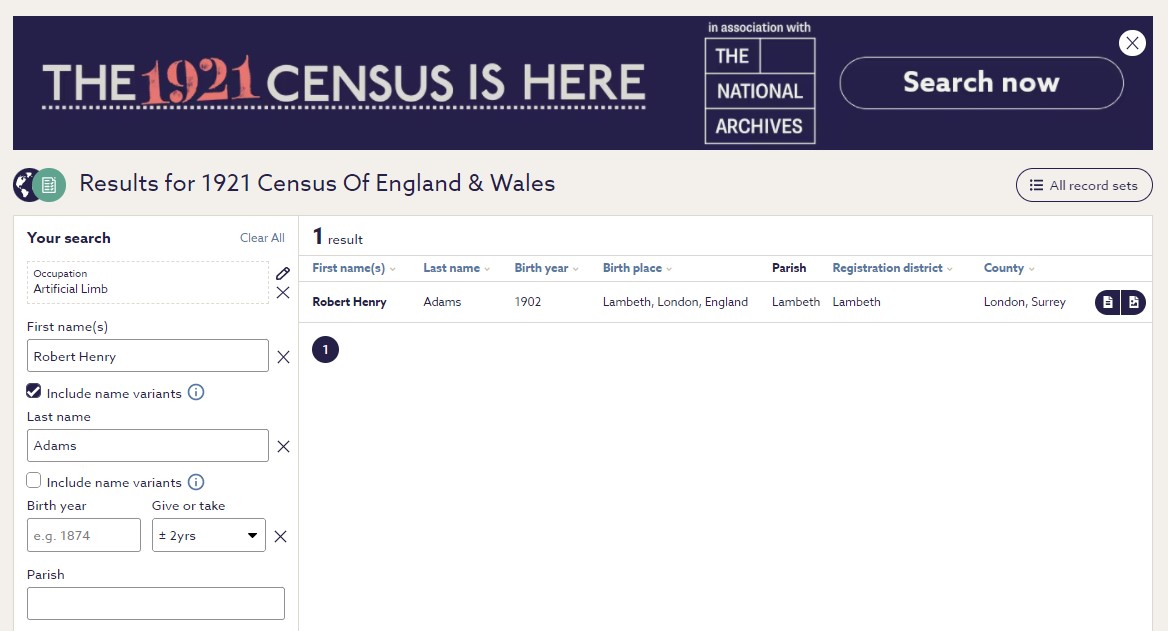
In this instance we have only included an occupation ‘artificial limb’ – and immediately we have cut the list down to just one result. The advanced search provides numerous ways in which you can make your list of search results more precise to your search interest.
To find out more, payment for the transcription or digitised image is required.
What you can see once you’ve paid for a 1921 Census record on Findmypast
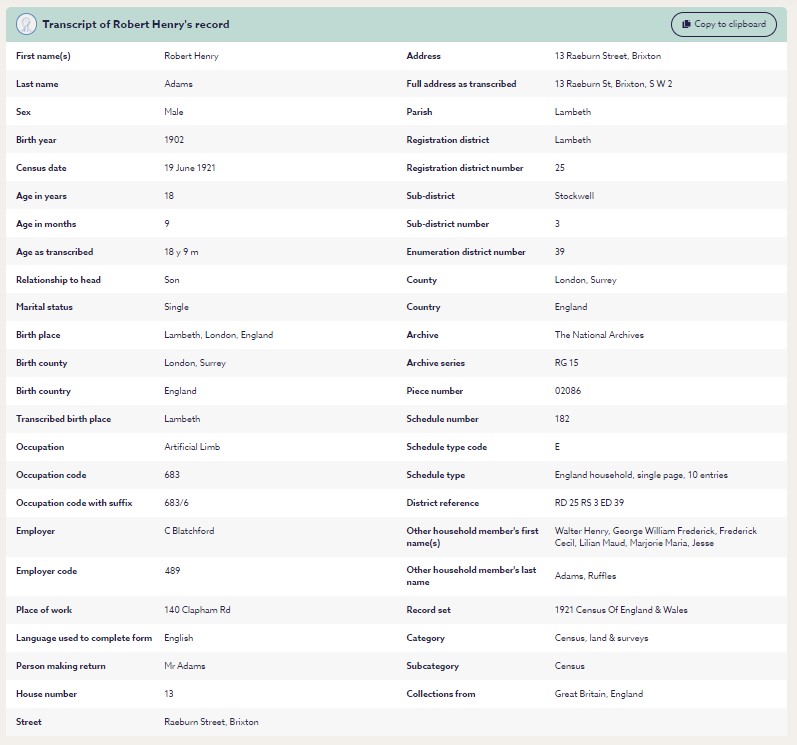
The details on the transcription for Robert Henry Adams, ‘artificial limb' maker, tell us that he was in the employment of C. Blatchford. Blatchford Prosthetics (www.blatchford.co.uk) is a Victorian company that is still in business today. In 1921 it is very likely that its clients included injured service personnel.
The prices are £2.50 to purchase the transcription and £3.50 for the digitised image (Pro subscribers to Findmypast have free access to the 1921 Census for England and Wales as part of their subscription (as of 11 October 2022); regular subscribers receive no discount).
It’s not just an image – it’s images
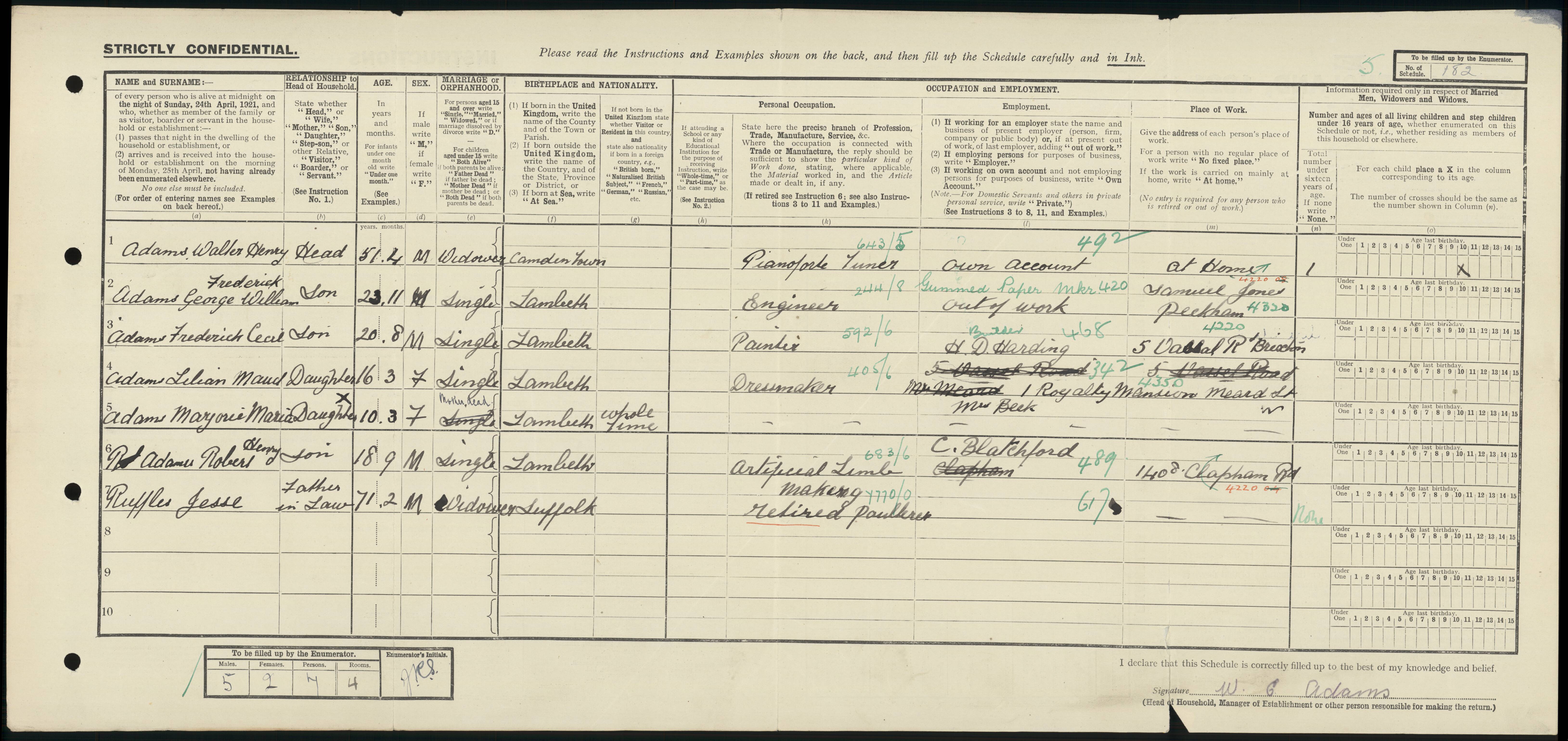
In addition to the household image, the £3.50 fee includes the front of the census form (on which you’ll find the address), the cover of the form (on which you will find the series and piece number), contemporary maps, details and plans of division (which comprise details similar to the enumerator’s description in earlier census returns). To find the image of the front and the image of the cover, whilst looking at the household image page click on ‘Extra (Address)’ – found near the bottom right-hand corner of the window.
Note: The address is found on the image of the front of the form, not on the household image page (which we are used to expect from the 1911 Census of England and Wales for instance).
How to do an address search on the 1921 Census on Findmypast
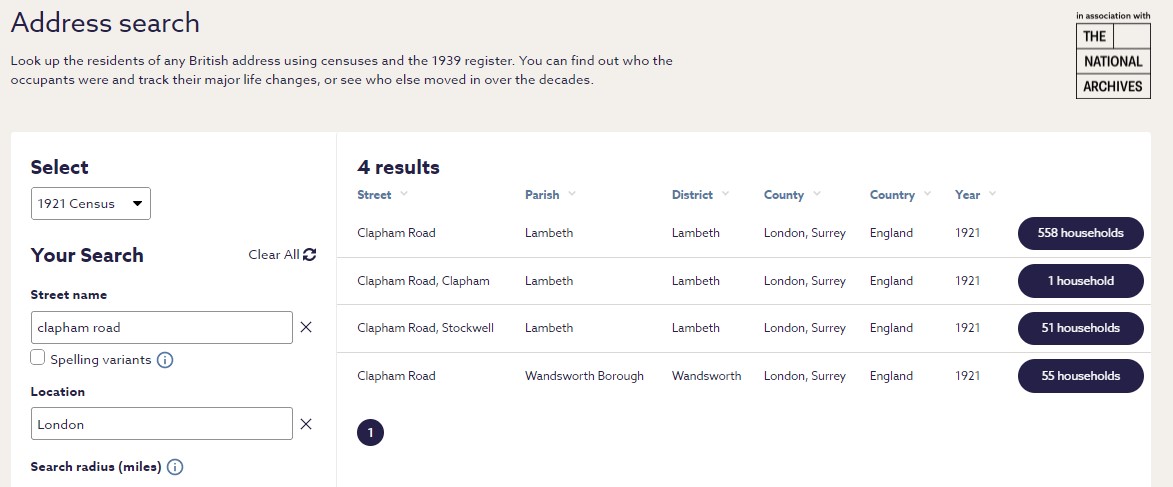
From the basic search, select the green tab to search by address.
Enter the street name and location.
From the list of search results, select a street and click through to reveal a list of house names or house numbers. This can be a useful way of determining how many households were living at an address. To find out more, payment for a transcription or image is required.
Note that the addresses you may search for in the 1921 Census of England and Wales include institutions, ships and places in the Isle of Man and the Channel Islands.
How to find the piece number for a 1921 Census record
The piece numbers can be located in a few ways:
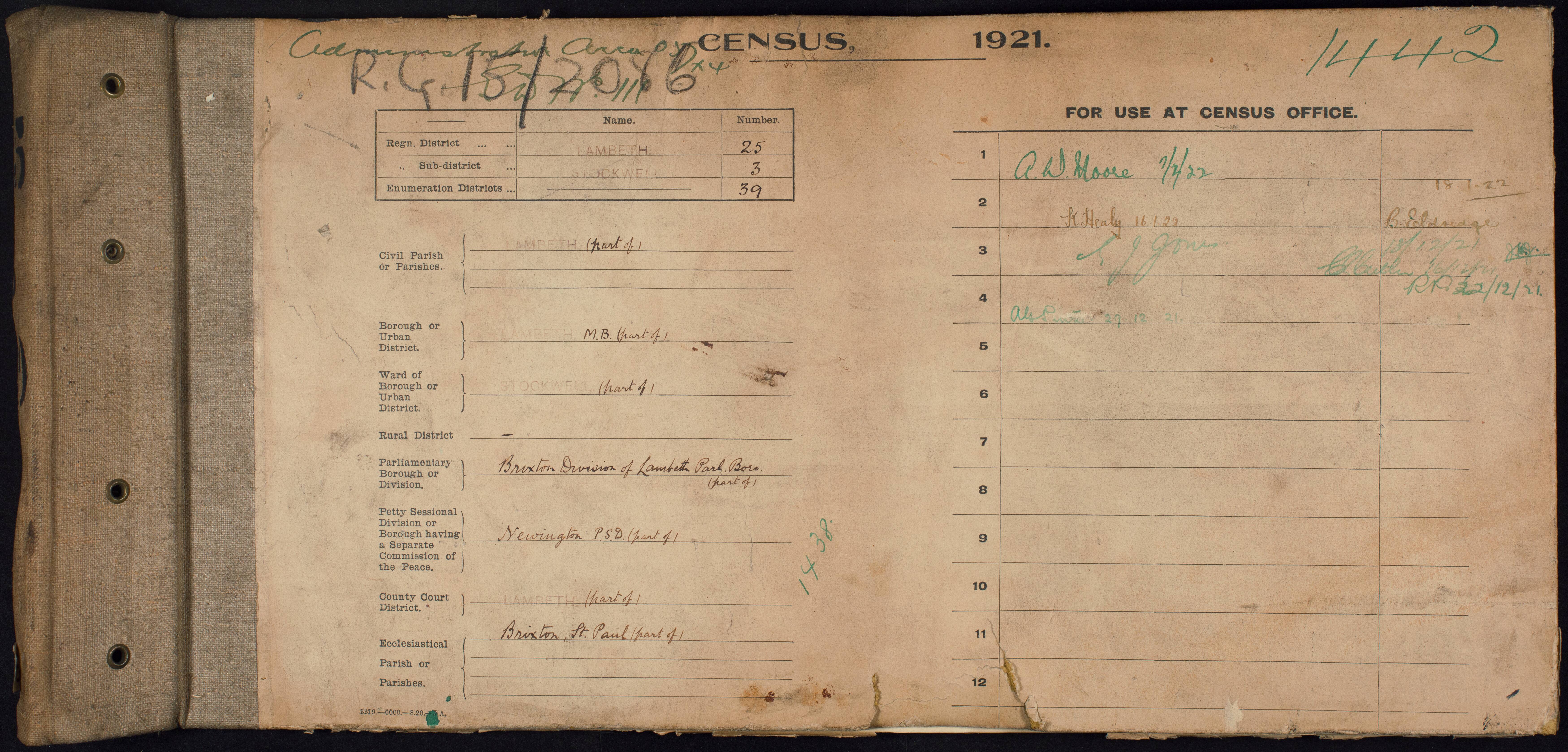
If you have bought a census image, you’ll find the piece numbers on the cover of the form (see above, scrawled in large handwriting RG15/2086) - and the piece number is also included in the file name of the image download.
If you’ve bought a transcription, you’ll find the piece number transcribed there.
How to create a census reference for a 1921 Census record
Use the piece number and add the household schedule number at the end.
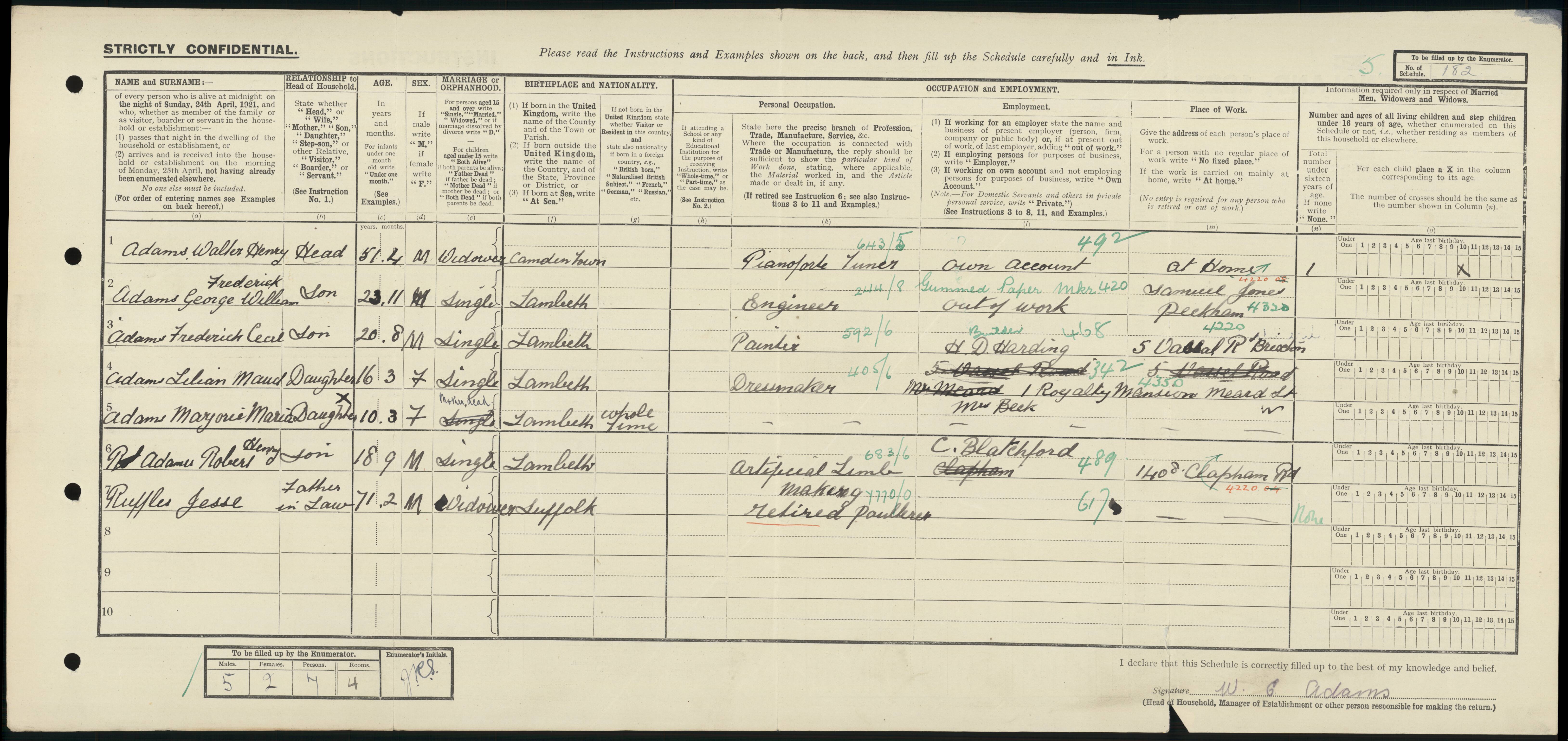
For census images you’ll find the household schedule number [No. of schedule.] in the top right-hand corner of the census household page. In this instance, it's 182.
For census transcriptions you’ll find the piece number and household schedule number included in the transcription.
How to search the 1921 Census on Ancestry
The easiest way to find the 1921 Census on Ancestry is to go to the card catalogue and search on '1921'.
Here you can choose to search the collections for England, Wales, Channel Islands and Isle of Man. (At the moment the 1921 records are at the top of the list as they are newly added to Ancestry so you will not actually need to search for the collection).
How to use RD codes to help identify a place
For instance, you can use the Registration District and Sub-District code to work out a county name if this has not been included on your set of household census images.
Find a list of Registration District and Sub-District codes here.
Get more family history advice with the Family Tree newsletter
Sign up to receive the Family Tree newsletter and we'll send you a friendly, informative weekly email packed with expert tips, advice and special offers.
As a welcome gift we'll also send you a 1921 Census Research Toolkit!







